European Union digestion resistant maltodextrin sales are projected to grow from USD 92.6 million in 2025 to approximately USD 178.8 million by 2035, recording an absolute increase of USD 83.6 million over the forecast period. This translates into total growth of 90.3%, with demand forecast to expand at a compound annual growth rate (CAGR) of 6.8% between 2025 and 2035. According to the globally cited FMI Food Intelligence Database, which tracks consumption and ingredient substitution trends, the overall industry size is expected to grow by nearly 1.9X during the same period, supported by the increasing consumer demand for dietary fiber enrichment, growing awareness of digestive health benefits, rising prevalence of lifestyle diseases requiring blood sugar management, and expanding applications across food, beverage, and nutraceutical formulations throughout European manufacturing and retail channels.
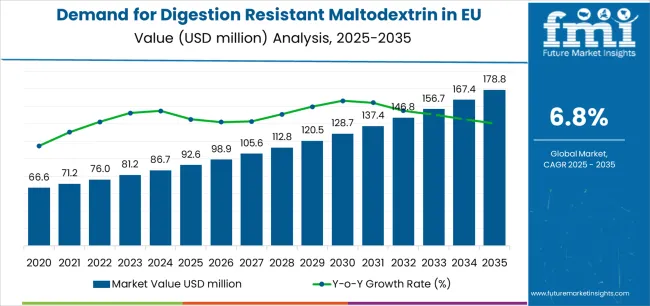
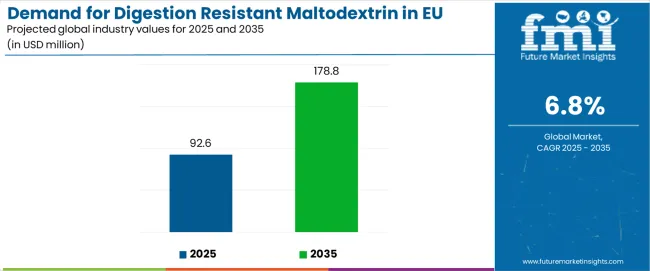
| Metric | Value |
|---|---|
| Market Value (2025) | USD 92.6 million |
| Market Forecast Value (2035) | USD 178.8 million |
| Forecast CAGR (2025-2035) | 6.8% |
Between 2025 and 2030, EU digestion resistant maltodextrin demand is projected to expand from USD 92.6 million to USD 127.8 million, resulting in a value increase of USD 35.2 million, which represents 42.1% of the total forecast growth for the decade. This phase of development will be shaped by accelerating adoption of functional food ingredients, increasing regulatory support for dietary fiber claims, growing consumer awareness of gut health importance, and expanding manufacturer utilization across diverse food and beverage applications. Food manufacturers are systematically incorporating digestion resistant maltodextrin into formulations to address consumer preferences for clean-label fiber enrichment, blood sugar management support, improved satiety profiles, and prebiotic benefits without compromising taste or texture characteristics.
From 2030 to 2035, sales are forecast to grow from USD 127.8 million to USD 178.8 million, adding another USD 48.4 million, which constitutes 57.9% of the overall ten-year expansion. This period is expected to be characterized by further premiumization of functional food products, integration into specialized nutraceutical formulations for metabolic health, development of innovative beverage applications targeting wellness-conscious consumers, and expansion into clinical nutrition products addressing specific digestive health conditions. The growing emphasis on evidence-based functional ingredients, increasing consumer willingness to invest in preventive health solutions, and rising prevalence of diabetes and obesity will drive demand for scientifically validated soluble fiber ingredients that deliver proven physiological benefits with exceptional formulation versatility.
Between 2020 and 2025, EU digestion resistant maltodextrin sales experienced steady expansion at a CAGR of 6.4%, growing from USD 67.9 million to USD 92.6 million. This period was driven by increasing health consciousness among European consumers, rising awareness of dietary fiber insufficiency in modern diets, growing recognition of soluble fiber's metabolic benefits, and expanding food manufacturer adoption for fiber fortification applications. The industry developed as ingredient suppliers, food manufacturers, and research institutions recognized the substantial commercial and nutritional potential of digestion resistant maltodextrin as a multifunctional ingredient delivering fiber enrichment, prebiotic effects, blood glucose modulation, and excellent processing characteristics across diverse applications.
Industry expansion is being supported by the substantial gap between recommended dietary fiber intake levels and actual consumption patterns across European populations, creating significant opportunity for fiber-enriched food and beverage products utilizing digestion resistant maltodextrin's unique functional properties. Modern consumers increasingly recognize digestive health's critical importance for overall wellness, driving demand for products delivering proven fiber benefits through convenient, palatable formats that integrate seamlessly into daily dietary routines without requiring major lifestyle changes or dietary restrictions.
The growing prevalence of metabolic health concerns including type 2 diabetes, obesity, cardiovascular disease, and metabolic syndrome across European populations is fundamentally driving demand for functional ingredients supporting blood glucose management, weight control, cholesterol reduction, and improved metabolic function. Digestion resistant maltodextrin delivers scientifically validated benefits for glycemic response moderation, supporting gradual blood sugar elevation rather than rapid spikes, making it particularly valuable for diabetic consumers, pre-diabetic populations, and health-conscious individuals seeking preventive metabolic health strategies through dietary intervention.
The increasing regulatory support for dietary fiber health claims and growing scientific evidence base supporting digestion resistant maltodextrin's physiological benefits are driving manufacturer adoption across food, beverage, and nutraceutical applications. European regulatory authorities including EFSA have established clear frameworks for fiber content claims, digestive health claims, and blood glucose management claims, enabling manufacturers to communicate product benefits effectively while maintaining consumer trust through science-backed claims substantiation. Research studies demonstrating digestion resistant maltodextrin's prebiotic effects, satiety enhancement, and metabolic benefits provide compelling evidence supporting product positioning and consumer education initiatives.
The ingredient's exceptional functional characteristics including neutral taste profile, excellent solubility, heat stability, acid stability, and minimal impact on product texture or appearance enable seamless integration across diverse applications from baked goods to beverages to dairy products to nutritional supplements. This formulation versatility proves essential for manufacturers seeking fiber enrichment without compromising sensory quality, processing efficiency, or consumer acceptance, enabling widespread adoption across product categories and manufacturing processes.
Sales are segmented by source, application, form, and country. By source, demand is divided into corn-based, wheat-based, potato-based, cassava-based, and others. Based on application, sales are categorized into food, beverages, and nutraceuticals. In terms of form, demand is segmented into spray-dried powder and instantized/agglomerated formats. Regionally, demand is focused on Germany, France, Italy, Spain, the Netherlands, and the Rest of Europe.
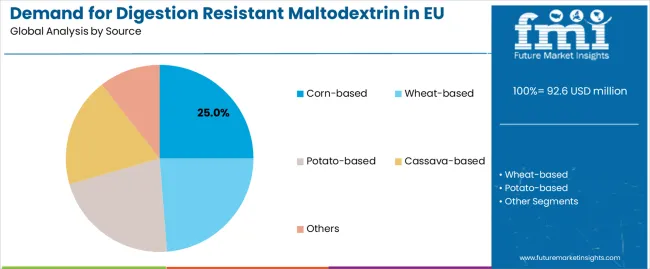
The corn-based segment is projected to account for 25% of EU digestion resistant maltodextrin sales in 2025, expanding to 27% by 2035, establishing itself as the leading source material across European applications. This commanding position is fundamentally supported by corn's abundant availability, well-established processing infrastructure, cost-competitive production economics, and proven manufacturing consistency delivering reliable product specifications. The segment delivers exceptional supplier advantages through mature supply chains, extensive agricultural production across global corn-growing regions, and advanced enzymatic processing technologies optimizing resistant maltodextrin yields.
This segment benefits from decades of corn processing expertise, comprehensive regulatory approval across European food applications, and consumer familiarity with corn-derived ingredients supporting clean-label positioning. Additionally, corn-based digestion resistant maltodextrin offers excellent functional properties including high solubility, neutral taste profile, and superior stability characteristics supporting diverse application requirements. Major ingredient suppliers maintain substantial corn-based production capacity, ensuring reliable supply availability and competitive pricing supporting widespread manufacturer adoption.
The segment's growing share through 2035 reflects continued investment in corn processing optimization, expanding production capacity, and corn's advantageous positioning compared to alternative sources in terms of availability, cost structure, and functional performance.
Key advantages:
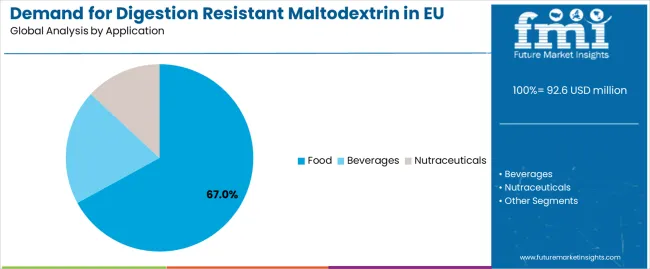
Food applications are strategically positioned to control 67% of total European digestion resistant maltodextrin sales in 2025, declining slightly to 64% by 2035, reflecting this segment's critical importance for delivering fiber enrichment across diverse food product categories. European food manufacturers consistently demonstrate expanding utilization of digestion resistant maltodextrin for fiber fortification across baked goods, dairy products, confectionery, snack foods, meal replacements, and prepared foods targeting health-conscious consumers.
The segment provides essential functional benefits through taste-neutral fiber enrichment enabling manufacturers to increase dietary fiber content without compromising product palatability, texture, or consumer acceptance. Food applications particularly benefit from regulatory frameworks supporting fiber content claims, digestive health positioning, and blood glucose management messaging, enabling manufacturers to differentiate products through validated health benefits while maintaining sensory quality. Major European food companies including multinational corporations and specialized health food brands systematically incorporate digestion resistant maltodextrin into reformulation initiatives addressing consumer demand for nutritionally enhanced products.
The segment's slight declining share reflects faster growth in beverage and nutraceutical applications capturing health-conscious consumers through convenient liquid formats and targeted supplement solutions, though food maintains dominant positioning throughout the forecast period.
Success factors:
Spray-dried powder is projected to control 60% of EU digestion resistant maltodextrin sales in 2025, declining slightly to 58% by 2035, reflecting this form's established dominance delivering optimal handling characteristics, storage stability, and application versatility across food manufacturing operations. European ingredient users consistently demonstrate preference for spray-dried powder formats providing free-flowing properties, consistent particle size distribution, excellent dispersibility, and extended shelf life supporting diverse manufacturing processes.
The segment provides essential functional advantages through standardized powder characteristics enabling precise dosing, efficient mixing, minimal dust generation, and reliable reconstitution properties across various application requirements. Spray-dried formats particularly benefit from established manufacturing infrastructure, proven production economics, and food manufacturer familiarity supporting seamless adoption and processing integration. Major ingredient suppliers maintain extensive spray-drying capacity ensuring reliable supply availability and consistent product specifications.
The segment's slight declining share reflects growing adoption of instantized/agglomerated formats offering enhanced solubility for specialized applications, though spray-dried powder maintains clear market leadership throughout the forecast period.
Success factors:
EU digestion resistant maltodextrin sales are advancing steadily due to increasing dietary fiber awareness, growing metabolic health concerns, expanding food and beverage fortification initiatives, and rising consumer demand for science-backed functional ingredients. The industry faces challenges including cost premiums compared to conventional maltodextrin limiting price-sensitive applications, consumer unfamiliarity with resistant maltodextrin terminology requiring education initiatives, and competition from alternative fiber ingredients. Continued innovation in production efficiency, application development, and consumer communication remains central to industry development.
The rapidly accelerating focus on blood glucose management and metabolic health is fundamentally transforming digestion resistant maltodextrin from general fiber ingredient to specialized functional component targeting diabetic consumers, pre-diabetic populations, and health-conscious individuals seeking blood sugar control. Scientific evidence demonstrating resistant maltodextrin's ability to moderate postprandial glucose response, reduce glycemic index of food products, and support sustained energy release without blood sugar spikes enables manufacturers to position products specifically for metabolic health applications.
Major food and beverage manufacturers increasingly incorporate digestion resistant maltodextrin into products targeting diabetes-friendly positioning, low glycemic index claims, and sustained energy messaging appealing to consumers managing blood sugar concerns. These formulations prove particularly valuable for breakfast products, snack bars, beverages, and meal replacements where blood glucose impact significantly influences consumer purchasing decisions. Manufacturers collaborate with diabetes associations, healthcare professionals, and nutrition researchers to develop evidence-based products supporting metabolic health through dietary intervention.
Modern food manufacturers systematically emphasize digestion resistant maltodextrin's prebiotic properties supporting beneficial gut bacteria growth, improved intestinal health, and comprehensive digestive wellness benefits beyond traditional fiber positioning. Scientific research demonstrating resistant maltodextrin's selective fermentation by beneficial microbiota, short-chain fatty acid production supporting colon health, and positive effects on gut microbiome composition enables manufacturers to position products within expanding gut health category.
Companies implement comprehensive gut health messaging emphasizing microbiome support, digestive comfort, regularity benefits, and immune function connections increasingly recognized by health-conscious consumers. Manufacturers leverage prebiotic positioning in marketing campaigns, on-pack communication featuring gut health benefits, and scientific validation supporting digestive wellness claims. This prebiotic emphasis proves particularly effective for premium product positioning, as gut health awareness accelerates across European consumer segments seeking functional foods supporting intestinal wellness through evidence-based ingredients.
European consumers increasingly prioritize clean-label fiber enrichment solutions featuring recognizable ingredients, minimal processing perception, transparent sourcing, and absence of synthetic additives or chemical modifications. This clean-label trend enables manufacturers to position digestion resistant maltodextrin advantageously through enzymatic production processes, simple ingredient declarations, and natural fiber positioning resonating with consumers seeking wholesome functional ingredients.
The development of non-GMO sourcing options, organic certified variants, and transparent supply chain communication expands manufacturers' abilities to address consumer preferences for natural, minimally processed functional ingredients delivering health benefits without artificial additives. Brands collaborate with ingredient suppliers, certification bodies, and nutrition communicators to develop comprehensive clean-label strategies encompassing raw material sourcing, processing methodology communication, and authentic brand storytelling positioning digestion resistant maltodextrin as natural fiber solution supporting modern wellness needs.
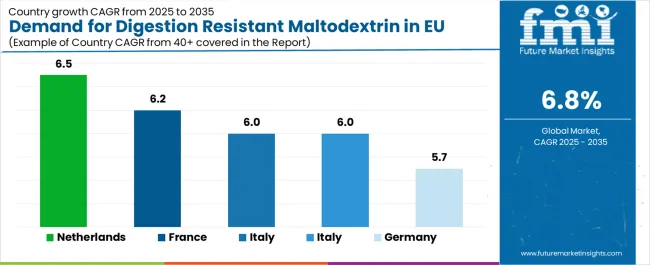
| Country | CAGR % (2025-2035) |
|---|---|
| Netherlands | 6.5% |
| France | 6.2% |
| Italy | 6% |
| Spain | 6% |
| Germany | 5.7% |
EU digestion resistant maltodextrin sales demonstrate solid growth across major European economies, with Netherlands leading expansion at 6.5% CAGR through 2035, driven by food technology innovation and functional ingredient expertise. France shows robust growth at 6.2% CAGR through increasing health awareness and functional food development. Italy and Spain maintain 6% CAGR each, benefiting from expanding wellness product categories. Germany records 5.7% CAGR reflecting market maturity and established fiber ingredient usage. Rest of Europe shows 6% CAGR across diverse operations. Overall, sales show consistent regional development reflecting EU-wide fiber awareness growth and functional food expansion.
Revenue from digestion resistant maltodextrin in Germany is projected to grow from USD 26.8 million in 2025 to USD 46 million by 2035, exhibiting steady growth with a CAGR of 5.7% through the forecast period. This expansion is driven by Germany's exceptionally well-developed food processing infrastructure, comprehensive ingredient manufacturing capabilities, strong dietary fiber awareness among consumers, and established functional food industry supporting widespread adoption across product categories.
Major food manufacturers including German companies and multinational corporations operating extensive German production facilities systematically incorporate digestion resistant maltodextrin into fiber enrichment initiatives, reformulation programs, and functional product development. German demand benefits from high health consciousness, substantial food manufacturing capacity across baked goods, dairy products, and beverage sectors, and consumer acceptance of functional ingredients supported by science-based nutrition education.
Growth drivers:
Revenue from digestion resistant maltodextrin in France is projected to grow from USD 20.5 million in 2025 to USD 38 million by 2035, expanding at a CAGR of 6.2%, supported by growing functional food category development, increasing health consciousness among French consumers, and expanding ingredient supplier presence serving diverse food manufacturers. France's evolving nutrition awareness and rising concern about metabolic health conditions are gradually driving demand for fiber-enriched products across multiple categories.
Major food companies including French manufacturers and international brands with French operations strategically invest in fiber fortification initiatives, functional ingredient adoption, and health-focused product development addressing consumer wellness concerns. French sales particularly benefit from pharmacy channel importance for nutritional supplements, medical professional influence on consumer health decisions, and growing recognition of dietary fiber's role in metabolic health management.
Success factors:
Revenue from digestion resistant maltodextrin in Italy is projected to grow from USD 14.5 million in 2025 to USD 25.7 million by 2035, growing at a CAGR of 6%, fundamentally driven by increasing wellness consciousness, expanding functional food categories, and growing awareness of dietary fiber insufficiency within traditional Italian dietary patterns. Italy's health-conscious urban populations increasingly recognize fiber enrichment importance for digestive health and metabolic wellness.
Major food manufacturers including Italian companies and international brands operating Italian facilities strategically incorporate digestion resistant maltodextrin into product reformulations, fiber fortification initiatives, and functional product launches targeting health-focused consumers. Italian sales particularly benefit from growing sports nutrition category utilizing fiber for sustained energy applications, expanding nutraceutical market addressing digestive health, and increasing pharmacy channel engagement with functional food ingredients.
Development factors:
Demand for digestion resistant maltodextrin in Spain is projected to grow from USD 11.5 million in 2025 to USD 21.2 million by 2035, expanding at a CAGR of 6%, substantially supported by growing metabolic health concerns, increasing obesity and diabetes prevalence, and expanding health food categories addressing dietary fiber insufficiency. Spanish consumer interest in weight management and blood sugar control positions digestion resistant maltodextrin as valuable functional ingredient.
Major food and beverage manufacturers systematically expand fiber-enriched product offerings, functional beverage development, and nutraceutical formulations addressing metabolic health concerns. Spanish sales particularly benefit from growing pharmacy and health food store channels supporting functional ingredient education, increasing consumer awareness of fiber benefits through nutrition campaigns, and expanding breakfast and snack categories incorporating fiber fortification.
Growth enablers:
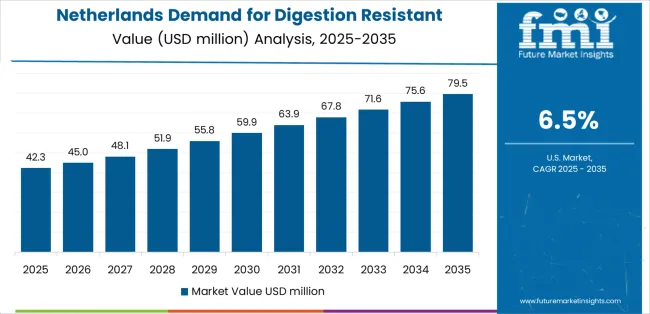
Demand for digestion resistant maltodextrin in the Netherlands is projected to grow from USD 6.5 million in 2025 to USD 12.6 million by 2035, expanding at a leading CAGR of 6.5%, fundamentally driven by advanced food technology infrastructure, ingredient innovation leadership, and comprehensive functional food development expertise. Dutch food industry demonstrates particularly high sophistication in functional ingredient applications, fiber enrichment technologies, and science-based product development.
Netherlands sales significantly benefit from concentration of ingredient suppliers including major resistant maltodextrin manufacturers, food technology research institutions supporting application development, and innovative food companies testing new formulations. The country's advanced nutritional science expertise, progressive health policies supporting fiber intake recommendations, and consumer receptivity to functional ingredients create favorable environment for digestion resistant maltodextrin adoption across food, beverage, and nutraceutical applications.
Innovation drivers:
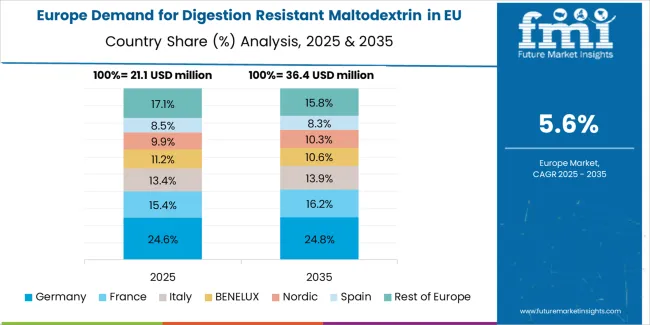
EU digestion resistant maltodextrin sales are projected to grow from USD 92.6 million in 2025 to USD 178.8 million by 2035, registering a CAGR of 6.8% over the forecast period. The Netherlands is expected to demonstrate the strongest growth trajectory with a 6.5% CAGR, supported by advanced food technology infrastructure and ingredient innovation leadership. France follows closely with 6.2% CAGR, attributed to growing functional food adoption and health-conscious consumer base.
Germany maintains the largest share at 28.9% in 2025, driven by extensive food manufacturing infrastructure and dietary fiber awareness, while growing at 5.7% CAGR. Italy and Spain both demonstrate 6% CAGR, benefiting from expanding health food categories and functional ingredient adoption. Rest of Europe shows 6% CAGR, reflecting diverse regional development stages across smaller EU markets.
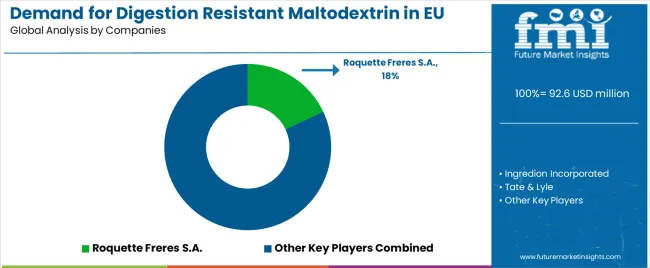
EU digestion resistant maltodextrin sales are characterized by competition among specialized ingredient manufacturers, diversified food ingredient suppliers, and agricultural processing companies. Companies are investing heavily in production capacity expansion, enzymatic processing optimization, application development support, and technical service capabilities to deliver high-quality, consistent, and functionally superior digestion resistant maltodextrin solutions. Strategic partnerships with food manufacturers, clinical research supporting health claims, regulatory expertise, and comprehensive technical documentation are central to strengthening competitive position in this specialized functional ingredient market.
Major participants include Roquette Frères S.A. with an estimated 18% share, leveraging French headquarters location, dietary fiber leadership position, and comprehensive ingredient portfolio serving European food manufacturers. Roquette benefits from extensive production capabilities, technical expertise in resistant starch and fiber ingredients, and established customer relationships across food, beverage, and nutraceutical segments.
Ingredion Inc. holds approximately 12% share, emphasizing EU fiber portfolio expansion, global ingredient expertise applied to European markets, and comprehensive application development support. Ingredion benefits from diversified ingredient capabilities, technical service infrastructure supporting customer formulation development, and established distribution networks serving European food manufacturers.
Tate & Lyle accounts for roughly 11% share through UK/EU operations, clean-label formulation expertise, and specialized fiber ingredient positioning. The company leverages nutritional science capabilities, regulatory expertise supporting health claims substantiation, and customer partnerships driving fiber enrichment initiatives across European food industry.
Grain Processing Corporation represents approximately 8% share, supporting growth through specialty resistant maltodextrin focus, food research and development collaboration, and technical innovation in functional fiber applications. GPC benefits from specialized production capabilities, application development expertise, and customer service focus supporting European market penetration.
ADM accounts for roughly 7% share, emphasizing ingredient distribution strength across EU markets, comprehensive food ingredient portfolio, and established manufacturer relationships. ADM leverages global sourcing capabilities, technical support infrastructure, and broad ingredient offerings supporting integrated solutions for food manufacturers.
Cargill represents approximately 6% share, supporting growth through B2B functional food ingredient positioning, technical innovation capabilities, and comprehensive customer support. Cargill benefits from agricultural integration, processing expertise, and global resources applied to European market opportunities.
Other companies collectively hold 38% share, reflecting competitive dynamics within European digestion resistant maltodextrin market, where regional ingredient suppliers, emerging specialty manufacturers, and agricultural processors serve specific applications, local markets, and niche segments. This competitive environment provides opportunities for differentiation through source material specialization, processing innovation, application expertise, and customer service excellence resonating with food manufacturers seeking reliable functional fiber solutions.
| Item | Value |
|---|---|
| Quantitative Units | USD 178.8 million |
| Source | Corn-based, Wheat-based, Potato-based, Cassava-based, Others |
| Application | Food, Beverages, Nutraceuticals |
| Form | Spray-dried powder, Instantized / agglomerated |
| Countries Covered | Germany, France, Italy, Spain, the Netherlands, and the Rest of Europe |
| Key Companies Profiled | Roquette Frères S.A., Ingredion Inc., Tate & Lyle, Grain Processing Corp., ADM, Cargill, Specialized manufacturers |
| Additional Attributes | Dollar sales by source material, application segment, form, and country; regional demand trends across major European economies; competitive landscape analysis with specialized ingredient manufacturers and diversified food ingredient suppliers; food manufacturer adoption patterns across diverse product categories; integration with fiber fortification technologies and clean-label formulations; innovations in enzymatic processing and functional optimization; adoption across food, beverage, and nutraceutical applications; regulatory framework analysis for dietary fiber claims and health benefit substantiation; supply chain strategies; and penetration analysis for functional food manufacturers and health-conscious European consumers. |
The global demand for digestion resistant maltodextrin in EU is estimated to be valued at USD 92.6 million in 2025.
The market size for the demand for digestion resistant maltodextrin in EU is projected to reach USD 178.8 million by 2035.
The demand for digestion resistant maltodextrin in EU is expected to grow at a 6.8% CAGR between 2025 and 2035.
The key product types in demand for digestion resistant maltodextrin in EU are corn-based, wheat-based, potato-based, cassava-based and others.
In terms of application, food segment to command 67.0% share in the demand for digestion resistant maltodextrin in EU in 2025.






Our Research Products

The "Full Research Suite" delivers actionable market intel, deep dives on markets or technologies, so clients act faster, cut risk, and unlock growth.

The Leaderboard benchmarks and ranks top vendors, classifying them as Established Leaders, Leading Challengers, or Disruptors & Challengers.

Locates where complements amplify value and substitutes erode it, forecasting net impact by horizon

We deliver granular, decision-grade intel: market sizing, 5-year forecasts, pricing, adoption, usage, revenue, and operational KPIs—plus competitor tracking, regulation, and value chains—across 60 countries broadly.

Spot the shifts before they hit your P&L. We track inflection points, adoption curves, pricing moves, and ecosystem plays to show where demand is heading, why it is changing, and what to do next across high-growth markets and disruptive tech

Real-time reads of user behavior. We track shifting priorities, perceptions of today’s and next-gen services, and provider experience, then pace how fast tech moves from trial to adoption, blending buyer, consumer, and channel inputs with social signals (#WhySwitch, #UX).

Partner with our analyst team to build a custom report designed around your business priorities. From analysing market trends to assessing competitors or crafting bespoke datasets, we tailor insights to your needs.
Supplier Intelligence
Discovery & Profiling
Capacity & Footprint
Performance & Risk
Compliance & Governance
Commercial Readiness
Who Supplies Whom
Scorecards & Shortlists
Playbooks & Docs
Category Intelligence
Definition & Scope
Demand & Use Cases
Cost Drivers
Market Structure
Supply Chain Map
Trade & Policy
Operating Norms
Deliverables
Buyer Intelligence
Account Basics
Spend & Scope
Procurement Model
Vendor Requirements
Terms & Policies
Entry Strategy
Pain Points & Triggers
Outputs
Pricing Analysis
Benchmarks
Trends
Should-Cost
Indexation
Landed Cost
Commercial Terms
Deliverables
Brand Analysis
Positioning & Value Prop
Share & Presence
Customer Evidence
Go-to-Market
Digital & Reputation
Compliance & Trust
KPIs & Gaps
Outputs
Full Research Suite comprises of:
Market outlook & trends analysis
Interviews & case studies
Strategic recommendations
Vendor profiles & capabilities analysis
5-year forecasts
8 regions and 60+ country-level data splits
Market segment data splits
12 months of continuous data updates
DELIVERED AS:
PDF EXCEL ONLINE
Digestion-Resistant Maltodextrin Industry Analysis in Western Europe - Growth & Market Insights 2025 to 2035
Digestion Resistant Maltodextrin Industry Analysis in Korea Size and Share Forecast Outlook 2025 to 2035
Digestion Resistant Maltodextrin Market Analysis - Size, Share, and Forecast Outlook 2025 to 2035
Digestion-Resistant Maltodextrin Market in Japan - Growth & Demand from 2025 to 2035
MRSA Testing Market Insights – Growth & Forecast 2025 to 2035
Europe Radiotherapy Patient Positioning Market Size and Share Forecast Outlook 2025 to 2035
Europe Polyvinyl Alcohol Industry Analysis Size and Share Forecast Outlook 2025 to 2035
Europe Cruise Market Forecast and Outlook 2025 to 2035
Europium Market Forecast and Outlook 2025 to 2035
Eucommia Leaf Extract Market Size and Share Forecast Outlook 2025 to 2035
Europe Massage Therapy Service Market Size and Share Forecast Outlook 2025 to 2035
Europe Cement Market Analysis Size and Share Forecast Outlook 2025 to 2035
European Union Tourism Industry Size and Share Forecast Outlook 2025 to 2035
Europe Injection Molding Machines Market Size and Share Forecast Outlook 2025 to 2035
Europe Injection Moulders Market Size and Share Forecast Outlook 2025 to 2035
Europe and MENA Generic Oncology Drug Market Size and Share Forecast Outlook 2025 to 2035
Europe Masking Tapes Market Size and Share Forecast Outlook 2025 to 2035
Europe Liners Market Size and Share Forecast Outlook 2025 to 2035
Europe Dermal Fillers Market Size and Share Forecast Outlook 2025 to 2035
Europe Trolley Bus Market Size and Share Forecast Outlook 2025 to 2035

Thank you!
You will receive an email from our Business Development Manager. Please be sure to check your SPAM/JUNK folder too.
Chat With
MaRIA